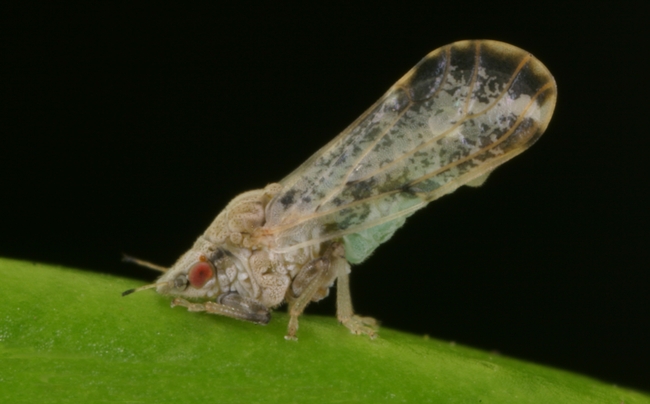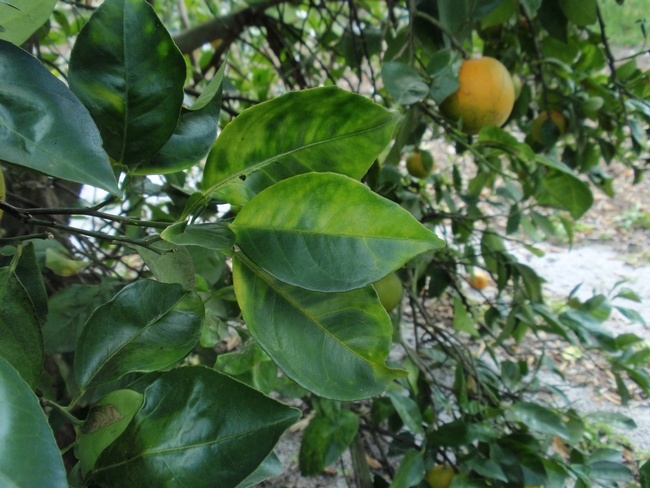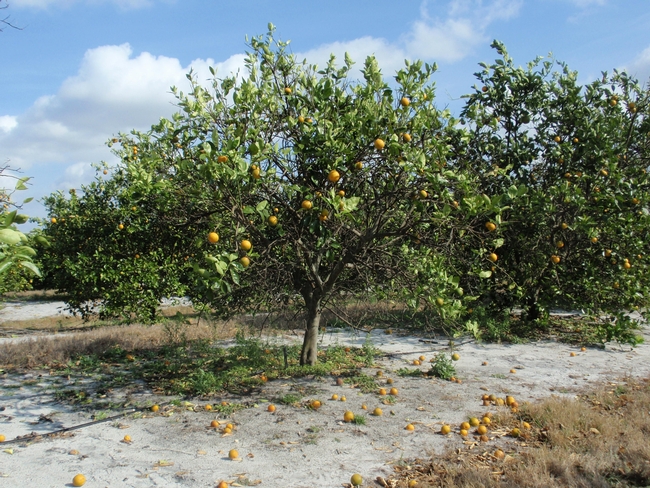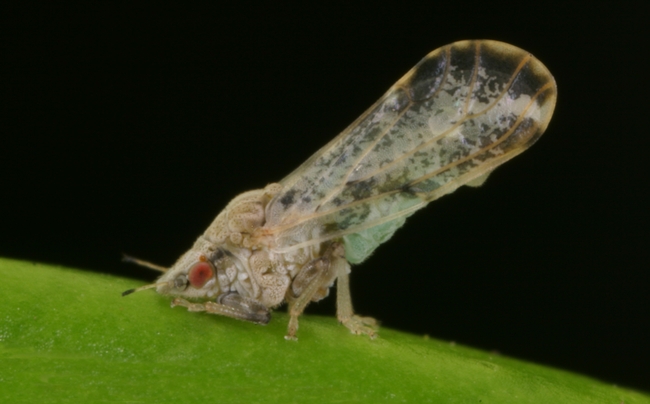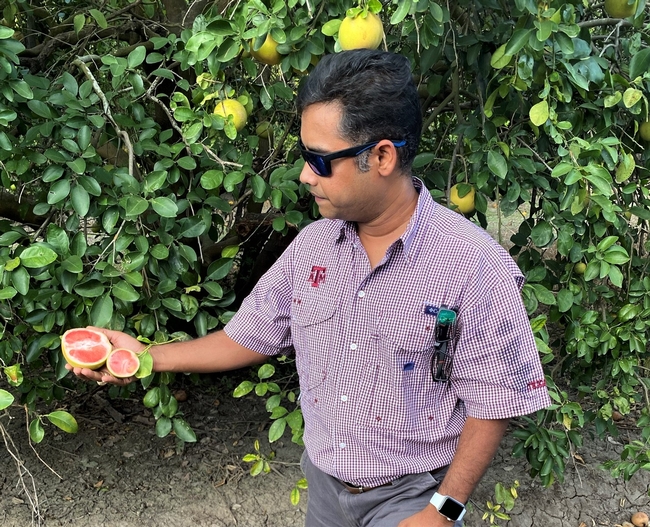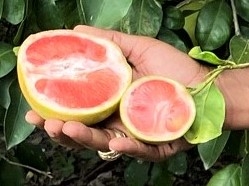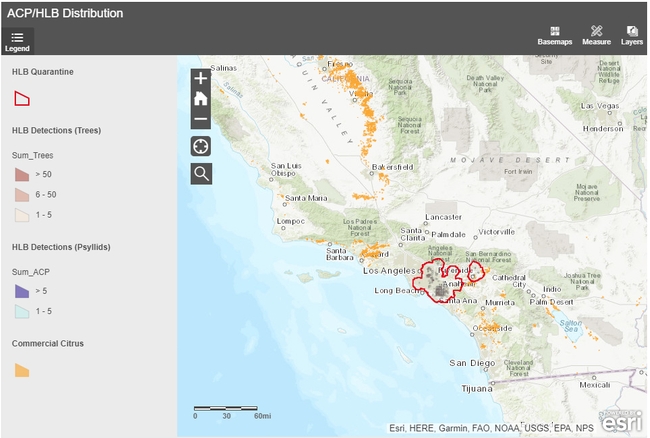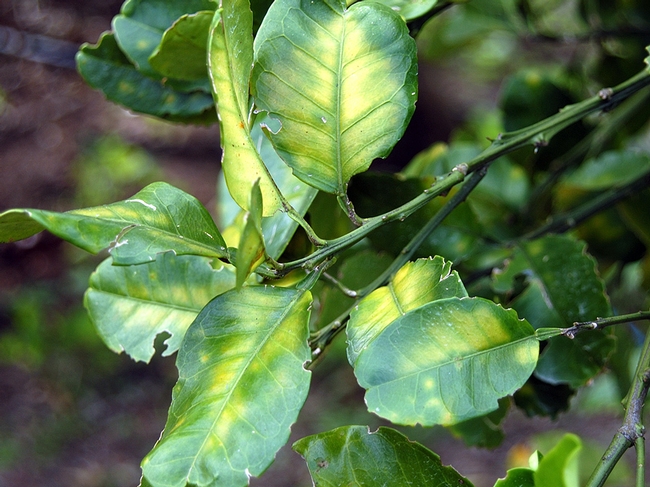
Posts Tagged: huanglongbing
Invasive Spotlight: Asian Citrus Psyllid and Huanglongbing Disease
The Asian Citrus Psyllid (ACP) is a small, aphid-sized insect that poses a serious threat to...
Asian citrus psyllid study: Vigilance urged but ‘no cause for panic’
Preliminary results indicate 3.5% of ACP collected showed signs of bacterium that can cause huanglongbing
An ongoing study in the commercial citrus groves of coastal Southern California is looking at whether Asian citrus psyllids – the insect vector of huanglongbing “citrus greening” disease – are carrying the bacterium that can cause HLB.
Thus far, the project has tested more than 3,000 adult ACP collected from 15 commercial citrus sites across the region, of which 138 – just over 3.5% – had some level of the bacterium present, according to researchers from UC Agriculture and Natural Resources, UC Davis, UC Riverside and the University of Arizona, Tucson.
“While the results are a cause for concern, the situation in California is much better than in Florida and Texas, where ACP carrying the bacterium make up the majority of the population and HLB is widespread in commercial citrus,” said Neil McRoberts, a UC Davis plant pathologist and UC Integrated Pest Management program affiliate advisor. “The results indicate that there is no room for complacency, but also no cause for panic.”
Since the first HLB-infected tree in California was found in 2012, nearly 4,000 infected trees have been detected and removed from residential properties in Southern California, mainly in Orange and Los Angeles counties. According to McRoberts, “to date, no HLB has been found in commercial citrus” in California.
He stressed, however, that the aforementioned ACP study – funded by the HLB Multi Agency Coordination Group and managed by USDA-APHIS – does not involve any testing of trees for HLB and focuses only on looking at the insect which spreads the bacterium.
McRoberts also emphasized that the project's detections of the bacterium cannot be considered “official” because the researchers' lab procedures differ from the official testing protocols of the California Department of Food and Agriculture.
“Follow-up sampling by CDFA staff would allow official samples to be collected for further investigation, but is entirely voluntary for the growers involved,” he said, adding that his research team is currently wrapping up the sampling phase of the project, with data analysis continuing into 2023.
While commending the “huge coordinated effort” by the California citrus industry, California Department of Food and Agriculture, UC ANR and other partners to suppress the ACP vector and slow the spread of HLB, McRoberts also urged continued vigilance.
“Our study results indicate that it is not time to declare the emergency status for ACP/HLB in California over – the situation is still evolving,” he said.
For further information about the research, contact Neil McRoberts at nmcroberts@ucdavis.edu or (530) 752-3248.
Citrus threat target of $7 million multistate research project
UC ANR part of team led by Texas A&M AgriLife combating huanglongbing disease
Citrus greening, or huanglongbing disease (HLB), is the most devastating disease for orange and grapefruit trees in the U.S. Prevention and treatment methods have proven elusive, and a definitive cure does not exist.
Since HLB was detected in Florida in 2005, Florida's citrus production has fallen by 80%. Although there have been no HLB positive trees detected in commercial groves in California, more than 2,700 HLB positive trees have been detected on residential properties in the greater Los Angeles region.
“It is likely only a matter of time when the disease will spread to commercial fields, so our strategy in California is to try to eradicate the insect vector of the disease, Asian citrus psyllid,” said Greg Douhan, University of California Cooperative Extension citrus advisor for Tulare, Fresno and Madera counties.
Now, a public-private collaborative effort across Texas, California, Florida and Indiana will draw on prior successes in research and innovation to advance new, environmentally friendly and commercially viable control strategies for huanglongbing.
Led by scientists from Texas A&M AgriLife Research, the team includes three UC Agriculture and Natural Resources experts: Douhan; Sonia Rios, UCCE subtropical horticulture advisor for Riverside and San Diego counties; and Ben Faber, UCCE advisor for Ventura, Santa Barbara and San Luis Obispo counties.
$7 million USDA project
The $7 million, four-year AgriLife Research project is part of an $11 million suite of grants from the U.S. Department of Agriculture National Institute of Food and Agriculture, NIFA, to combat HLB. The coordinated agricultural project is also a NIFA Center of Excellence.
“Through multistate, interdisciplinary collaborations among universities, regulatory affairs consultants, state and federal agencies, and the citrus industry, we will pursue advanced testing and commercialization of promising therapies and extend outcomes to stakeholders,” said lead investigator Kranthi Mandadi, an AgriLife Research scientist at Weslaco and associate professor in the Department of Plant Pathology and Microbiology at the Texas A&M College of Agriculture and Life Sciences.
The UC ANR members of this collaboration will be responsible for sharing findings from the research with local citrus growers across Southern California, the desert region, the coastal region and the San Joaquin Valley.
“In addition to the ground-breaking research that will be taking place, this project will also help us continue to generate awareness and outreach and share the advancements taking place in the research that is currently being done to help protect California's citrus industry,” said Rios, the project's lead principal investigator in California.
Other institutions on the team include Texas A&M University-Kingsville Citrus Center, University of Florida, Southern Gardens Citrus, Purdue University and USDA Agricultural Research Service.
“This collaboration is an inspiring example of how research, industry, extension and outreach can create solutions that benefit everyone,” said Patrick J. Stover, vice chancellor of Texas A&M AgriLife, dean of the Texas A&M College of Agriculture and Life Sciences and director of Texas A&M AgriLife Research.
HLB solutions must overcome known challenges
An effective HLB treatment must avoid numerous pitfalls, Mandadi explained.
One major problem is getting a treatment to the infected inner parts of the tree. The disease-causing bacteria only infect a network of cells called the phloem, which distributes nutrients throughout a tree. Starved of nutrients, infected trees bear low-quality fruits and have shortened lifespans.
Treatments must reach the phloem to kill the bacteria. So, spraying treatments on leaves has little chance of success because citrus leaves' waxy coating usually prevents the treatments from penetrating.
Second, while the bacteria thrive in phloem, they do not grow in a petri dish. Until recently, scientists wishing to test treatments could only do so in living trees, in a slow and laborious process.
Third, orange and grapefruit trees are quite susceptible to the disease-causing bacteria and do not build immunity on their own. Strict quarantines are in place. Treatments must be tested in groves that are already infected.
Two types of potential HLB therapies will be tested using novel technologies
The teams will be working to advance two main types of treatment, employing technologies they've developed in the past to overcome the problems mentioned above.
First, a few years ago, Mandadi and his colleagues discovered a way to propagate the HLB-causing bacteria in the lab. This method involves growing the bacteria in tiny, root-like structures developed from infected trees. The team will use this so-called “hairy roots” method to screen treatments much faster than would be possible in citrus trees.

“Even though a particular peptide may have efficacy in the lab, we won't know if it will be expressed in sufficient levels in a tree and for enough time to kill the bacteria,” Mandadi said. “Viruses are smart, and sometimes they throw the peptide out. Field trials are crucial.”
The second type of treatment to undergo testing is synthetic or naturally occurring small molecules that may kill HLB-causing bacteria. Again, Mandadi's team will screen the molecules in hairy roots. A multistate team will further test the efficacy of the most promising molecules by injecting them into trunks of infected trees in the field.
A feasible HLB treatment is effective and profitable
Another hurdle to overcome is ensuring that growers and consumers accept the products the team develops.
“We have to convince producers that the use of therapies is profitable and consumers that the fruit from treated trees would be safe to eat,” Mandadi said.
Therefore, a multistate economics and marketing team will conduct studies to determine the extent of economic benefits to citrus growers. In addition, a multistate extension and outreach team will use diverse outlets to disseminate project information to stakeholders. This team will also survey growers to gauge how likely they are to try the treatments.
“The research team will be informed by those surveys,” Mandadi said. “We will also engage a project advisory board of representatives from academia, universities, state and federal agencies, industry, and growers. While we are doing the science, the advisory board will provide guidance on both the technical and practical aspects of the project.”
Project team members:
—Kranthi Mandadi, Texas A&M AgriLife Research.
—Mike Irey, Southern Gardens Citrus, Florida.
—Choaa El-Mohtar, University of Florida Institute of Food and Agricultural Sciences, Citrus Research and Education Center.
—Ray Yokomi, USDA-Agricultural Research Service, Parlier, California.
—Ute Albrecht, University of Florida IFAS Southwest Florida Research and Education Center.
—Veronica Ancona, Texas A&M University-Kingsville Citrus Center.
—Freddy Ibanez-Carrasco, Texas A&M AgriLife Research, Department of Entomology, Weslaco.
—Sonia Irigoyen, AgriLife Research, Texas A&M AgriLife Research and Extension Center at Weslaco.
—Ariel Singerman, University of Florida IFAS Citrus Research and Education Center.
—Jinha Jung, Purdue University, Indiana.
—Juan Enciso, Texas A&M AgriLife Research, Department of Biological and Agricultural Engineering, Weslaco.
—Samuel Zapata, Texas A&M AgriLife Extension, Department of Agricultural Economics, Weslaco.
—Olufemi Alabi, Texas A&M AgriLife Extension, Department of Plant Pathology and Microbiology, Weslaco.
—Sonia Rios, University of California Cooperative Extension, Riverside and San Diego counties.
—Ben Faber, University of California Cooperative Extension, Ventura, Santa Barbara and San Luis Obispo counties.
—Greg Douhan, University of California Cooperative Extension, Tulare, Fresno and Madera counties.
Asian citrus psyllid infected with huanglongbing disease found in Riverside citrus grove
The recent identification of an Asian citrus psyllid infected with huanglongbing disease in a Riverside commercial citrus grove isn't surprising, said UC Cooperative Extension specialist Monique Rivera in an interview with Brian German of AgNetWest.
"We've had positive trees removed here in Riverside and we're not that far from LA," Rivera said. "Eventually those two quarantine circles are likely to merge here in Southern California."
Rivera said an HLB-infected ACP hasn't been found in Riverside commercial citrus before because CDFA is mainly responsible for sampling ACP in backyard trees. "They aren't looking directly or systematically at commercial groves," she said.
There are resources available for growers to test ACPs found in their citrus orchards. Growers can request PCR testing of ACP or plant samples from an accredited lab, such as the Citrus Pest Detection Program (CPDP) which is operated by the Central California Tristeza Eradication Agency. CDFA will also collect samples for analysis at no cost to the grower.
UC Riverside researcher discovers first effective treatment for citrus-destroying disease
UC Riverside scientists have found the first substance capable of controlling Citrus Greening Disease, which has devastated citrus farms in Florida and also threatens California.
The new treatment effectively kills the bacterium causing the disease with a naturally occurring molecule found in wild citrus relatives. This molecule, an antimicrobial peptide, offers numerous advantages over the antibiotics currently used to treat the disease.
UCR geneticist Hailing Jin, who discovered the cure after a five-year search, explained that unlike antibiotic sprays, the peptide is stable even when used outdoors in high heat, easy to manufacture, and safe for humans.
“This peptide is found in the fruit of greening-tolerant Australian finger limes, which has been consumed for hundreds of years,” Jin said. “It is much safer to use this natural plant product on agricultural crops than other synthetic chemicals.”
Currently, some growers in Florida are spraying antibiotics and pesticides in an attempt to save trees from the CLas bacterium that causes citrus greening, also known as Huanglongbing or HLB.
“Most antibiotics are temperature sensitive, so their effects are largely reduced when applied in the hot weather,” Jin said. “By contrast, this peptide is stable even when used in 130-degree heat.”
Jin found the peptide by examining plants such as the Australian finger lime known to possess natural tolerance for the bacteria that causes Citrus Greening Disease, and she isolated the genes that contribute to this innate immunity. One of these genes produces the peptide, which she then tested over the course of two years. Improvement was soon visible.
“You can see the bacteria drastically reduced, and the leaves appear healthy again only a few months after treatment,” Jin said.
Because the peptide only needs to be reapplied a few times per year, it is highly cost effective for growers. This peptide can also be developed into a vaccine-like solution to protect young healthy plants from infection, as it is able to induce the plant's innate immunity to the bacteria.
Jin's peptide can be applied by injection or foliage spray, and it moves systemically through plants and remains stable, which makes the effect of the treatment stronger.
The treatment will be further enhanced with proprietary injection technology made by Invaio Sciences. UC Riverside has entered into an exclusive, worldwide license agreement with Invaio, ensuring this new treatment goes exactly where it's needed in plants.
“Invaio is enthusiastic to partner with UC Riverside and advance this innovative technology for combating the disease known as Citrus Greening or Huanglongbing,” said Invaio Chief Science Officer Gerardo Ramos. “The prospect of addressing this previously incurable and devastating crop disease, helping agricultural communities and improving the environmental impact of production is exciting and rewarding,” he said. “This is crop protection in harmony with nature.”
The need for an HLB cure is a global problem, but hits especially close to home as California produces 80 percent of all the fresh citrus in the United States, said Brian Suh, director of technology commercialization in UCR's Office of Technology Partnerships, which helps bring university technology to market for the benefit of society through licenses, partnerships, and startup companies.
“This license to Invaio opens up the opportunity for a product to get to market faster,” Suh said. “Cutting edge research from UCR, like the peptide identified by Dr. Jin, has a tremendous amount of commercial potential and can transform the trajectory of real-world problems with these innovative solutions.”

